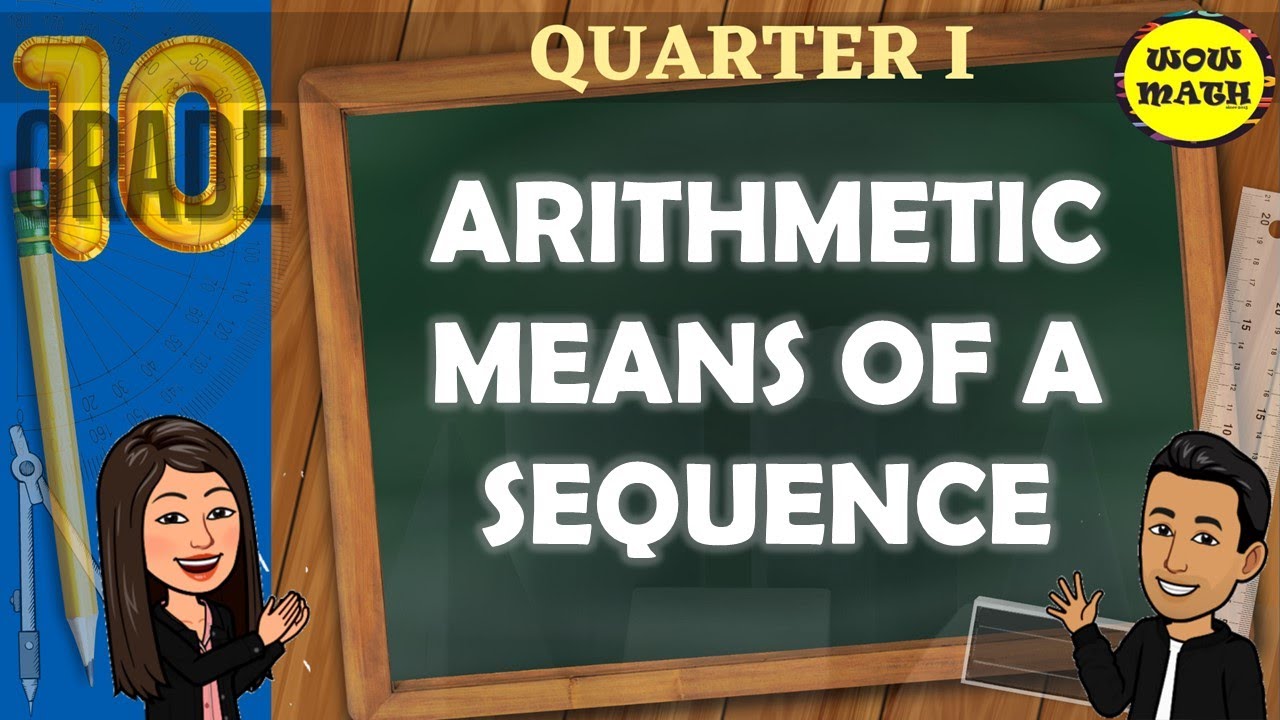Grade 10 Math Q1 Ep4: Computing Arithmetic Means
Summary
TLDRIn today's episode of 'Adapted TV,' host Sir Jason Flores, also known as Math Buddy, guides viewers through the concept of arithmetic means in sequences. The lesson focuses on defining arithmetic means, identifying them within a sequence, and calculating them using the formula for the common difference. Examples include finding means between given extremes and inserting specified numbers of means between extremes. The engaging tutorial aims to enhance logical reasoning and critical thinking skills, making math fun and accessible.
Takeaways
- 📘 Arithmetic means are the numbers that lie between the first and last terms of a finite arithmetic sequence.
- 🔢 The arithmetic extremes are the first and last terms of an arithmetic sequence, with the terms in between being the arithmetic means.
- 💡 To find the arithmetic mean between two numbers, sum them and divide by two, which is also known as the average.
- 📐 The formula to calculate the common difference D in an arithmetic sequence is D = (a_n - a_k) / (n - k), where a_n is the last term and a_k is the first term.
- 📈 The common difference can be used to find the missing terms in an arithmetic sequence by adding it to the preceding term.
- 📝 When inserting multiple arithmetic means between two extremes, the sequence's terms are calculated using the common difference.
- 📊 The arithmetic mean of an arithmetic sequence can be represented as the average of the first and last terms.
- 📌 In the context of the script, examples are provided to demonstrate how to find arithmetic means and insert terms into a sequence.
- 🎓 The lesson encourages students to practice and apply these concepts to solve problems involving arithmetic sequences.
- 🎉 The video concludes with a reminder that learning math can be fun and easy, emphasizing a positive learning attitude.
Q & A
What are the arithmetic extremes in a finite arithmetic sequence?
-The first and last terms of a finite arithmetic sequence are called arithmetic extremes.
What is the term used for the numbers that lie between the arithmetic extremes in a sequence?
-The numbers that lie between the arithmetic extremes in a sequence are referred to as arithmetic means.
How is the arithmetic mean between two numbers calculated?
-The arithmetic mean between two numbers is calculated by adding the two numbers together and dividing the sum by two.
What formula is used to find the common difference when inserting arithmetic means between two extremes?
-The formula used to find the common difference \( D \) is \( D = \frac{a_n - a_K}{N - K} \), where \( a_n \) is the last term, \( a_K \) is the first term, and \( N \) and \( K \) are the positions of the last and first terms, respectively.
How do you find the arithmetic mean of the sequence 4, 8, 12, 16, 20, and 24?
-The arithmetic means of the sequence 4, 8, 12, 16, 20, and 24 are the terms 8, 12, 16, and 20, as they lie between the first and last terms, 4 and 24.
What is the arithmetic mean between 10 and 24?
-The arithmetic mean between 10 and 24 is 17, which is calculated by adding 10 and 24 to get 34, then dividing by 2.
How many arithmetic means are there between 8 and 16 if three means are inserted?
-When three arithmetic means are inserted between 8 and 16, there are a total of five terms including the extremes, with the three arithmetic means being 10, 12, and 14.
What is the formula to find the common difference in an arithmetic sequence?
-The formula to find the common difference \( D \) in an arithmetic sequence is \( D = \frac{a_n - a_1}{n - 1} \), where \( a_n \) is the last term, \( a_1 \) is the first term, and \( n \) is the number of terms.
How do you determine the missing terms in an arithmetic sequence when the second and fifth terms are known?
-To determine the missing terms in an arithmetic sequence when the second and fifth terms are known, first find the common difference using the formula for \( D \), then add this difference to the preceding term to find the next term.
What is the arithmetic mean between the arithmetic extremes 5 and 19?
-The arithmetic mean between the arithmetic extremes 5 and 19 is 12, calculated by adding 5 and 19 to get 24, then dividing by 2.
How many arithmetic means should be inserted between -5 and 1 if two means are to be added?
-If two arithmetic means are to be inserted between -5 and 1, the common difference \( D \) is calculated to be 2, and the terms would be -3 and -1.
Outlines

Этот раздел доступен только подписчикам платных тарифов. Пожалуйста, перейдите на платный тариф для доступа.
Перейти на платный тарифMindmap

Этот раздел доступен только подписчикам платных тарифов. Пожалуйста, перейдите на платный тариф для доступа.
Перейти на платный тарифKeywords

Этот раздел доступен только подписчикам платных тарифов. Пожалуйста, перейдите на платный тариф для доступа.
Перейти на платный тарифHighlights

Этот раздел доступен только подписчикам платных тарифов. Пожалуйста, перейдите на платный тариф для доступа.
Перейти на платный тарифTranscripts

Этот раздел доступен только подписчикам платных тарифов. Пожалуйста, перейдите на платный тариф для доступа.
Перейти на платный тарифПосмотреть больше похожих видео

Grade 10 Math Q1 Ep6: Geometric Sequence VS Arithmetic Sequence

Grade 10 Math Q1 Ep7: Finding the nTH term of a Geometric Sequence and Geometric Means

Grade 10 Math Q1 Ep5: Finding the Sum of the Terms of a Given Arithmetic Sequence

Grade 10 Math Q1 Ep2: Generate Patterns From a Given Succession of Objects

Grade 10 MATH Q1 Ep3: Write and Use the Formula of the nth Term of an Arithmetic Sequences

ARITHMETIC MEANS OF A SEQUENCE || GRADE 10 MATHEMATICS Q1
5.0 / 5 (0 votes)
